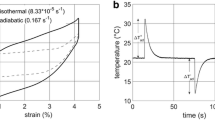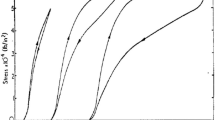Abstract
The present effort provides a 3-D thermodynamic framework generalizing the 1-D modeling of 2-way shape memory materials described by Westbrook et al. (J. Eng. Mater. Technol. 312:041010, 2010) and Chung et al. (Macromolecules 41:184–192, 2008), while extending the strain-induced crystallization and shape memory approaches of Rao and Rajagopal (Interfaces Free Bound. 2:73–94, 2000; Int. J. Solids Struct. 38:1149–1167, 2001), Barot and Rao (Z. Angew. Math. Phys. 57:652–681, 2006), and Barot et al. (Int. J. Eng. Sci. 46:325–351, 2008) to include finite thermal expansion within a logarithmic strain basis. The free energy of newly-formed orthotropic crystallites is assumed additive, with no strains in their respective configurations of formation. A multiplicative decomposition is assumed for the assumed thermoelastic orthotropic expansional strains of the respective crystallites. The properties of the crystallites are allowed to depend both on current temperature and their respective temperatures of formation. The entropy production rate relation is written in the frame rotating with the logarithmic spin and produces stress and entropy relations incorporating the integrated configurational free energies, and a driving term for the crystallization analogous to that obtained by the previous studies of Rao et al. The salient attributes of the 1-D modeling of Westbrook et al. are recovered, and applications are discussed.
Similar content being viewed by others
Notes
\(\mathbf{L}_{\kappa_{\gamma}}^{M\theta}\) is associated with both configurations κ γ and θ γ , γ=r or c[s].
The density is assumed constant, see remarks following Eq. (41). The present mixture construction readily admits different constant phase densities when justified.
The term “melt” is used here, as is commonplace in the description of shape-memory polymer behavior, e.g., International Union of Pure and Applied Chemistry (2012), Chung et al. (2008), to describe the transition between crystalline and rubbery elastic states void of macroscopic flow. The term is employed strictly for convenience; the more accurate terminology, “transition to the amorphous phase,” could be employed (Barot et al. 2008) but would be cumbersome in the present context.
References
Barot, G., Rao, I.J.: Constitutive modeling of the mechanics associated with crystallizable shape memory polymers. Z. Angew. Math. Phys. 57, 652–681 (2006)
Barot, G., Rao, I.J., Rajagopal, K.R.: A thermodynamic framework for the modeling of crystallizable shape memory polymers. Int. J. Eng. Sci. 46, 325–351 (2008)
Chung, T., Romo-Uribe, A., Mather, P.T.: Two-way reversible shape memory in a semicrystalline network. Macromolecules 41, 184–192 (2008)
International Union of Pure and Applied Chemistry: Compendium of Chemical Terminology Gold Book, Version 2.3.2 (2012). http://goldbook.iupac.org/ST07194.html, “shape-memory polymer”
Malvern, L.M.: Introduction to the Mechanics of a Continuous Medium. Prentice-Hall, Englewood Cliffs (1969)
Rajagopal, K.R., Wineman, A.S.: A constitutive equation for nonlinear solids which undergo deformation induced microstructural changes. Int. J. Plast. 8, 385–395 (1992)
Rao, I.J., Rajagopal, K.R.: Phenomenological modelling of polymer crystallization using the notion of multiple natural configurations. Interfaces Free Bound. 2, 73–94 (2000)
Rao, I.J., Rajagopal, K.R.: A study of strain-induced crystallization of polymers. Int. J. Solids Struct. 38, 1149–1167 (2001)
Spencer, A.J.M.: Constitutive theory for strongly anisotropic solids. In: Continuum Theory of the Mechanics of Fibre-Reinforced Composites. CISM Courses and Lectures, vol. 282, pp. 1–71. Springer, New York (1984)
Starkova, O., Aniskevich, A.: Poisson’s ratio and the incompressibility relation for various strain measures with the example of a silica-filled SBR rubber in uniaxial tension tests. Polym. Test. 29, 310–318 (2010)
Westbrook, K., et al.: Constitutive modeling of shape memory effects in semicrystalline polymers with stretch induced crystallization. J. Eng. Mater. Technol. 312, 041010 (2010)
Xiao, H., Bruhns, O.T., Meyers, A.: Objective corotational rates and unified work-conjugacy relation between Eulerian and lagrangean strain and stress measures. Arch. Mech. 50(6), 1015–1045 (1998)
Xiao, H., Bruhns, O.T., Meyers, A.: Thermodynamic laws and consistent Eulerian formulation of finite elastoplasticity with thermal effects. J. Mech. Phys. Solids 55, 338–365 (2007)
Author information
Authors and Affiliations
Corresponding author
Rights and permissions
About this article
Cite this article
Hall, R.B., Rao, I.J. & Qi, H.J. Thermodynamics and thermal decomposition for shape memory effects with crystallization based on dissipation and logarithmic strain. Mech Time-Depend Mater 18, 437–452 (2014). https://doi.org/10.1007/s11043-014-9236-6
Received:
Accepted:
Published:
Issue Date:
DOI: https://doi.org/10.1007/s11043-014-9236-6




